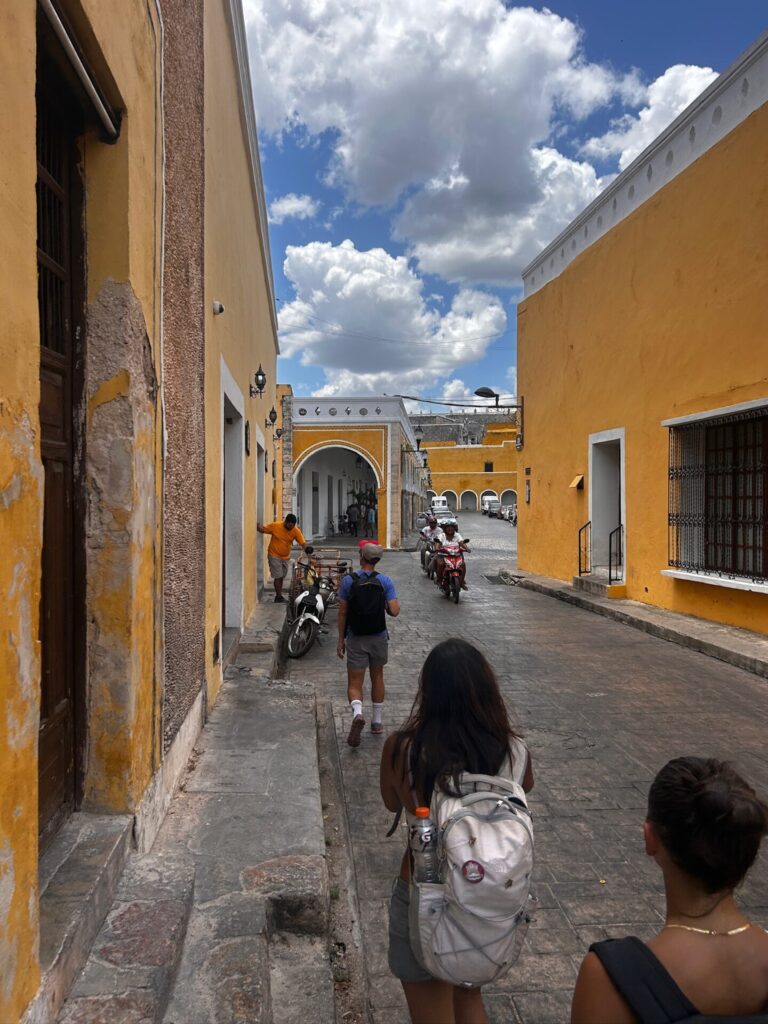It has been 11 days since my classmates and I returned home. Since then, I have fielded many questions asking how my trip was. My answer is always “I learned way more than I thought I would.” My pre-conceived notions about Mexico, the legacies of colonialism, and tourism as a whole were challenged and put into a brand new perspective. Walking through the streets of Merida, learning about the life and times of the native Mayan people, and then once again hitting the streets with an open eye was truly a mind-blowing experience.
I took a particular interest in Izamal. The monolithic catholic cathedral is a great symbol of the state of Yucatan and the Mayan people post-Columbus. The cathedral itself contains stones and building blocks taken from destroyed Mayan buildings. This is known as spolia, and is latin for “spoils.” From Jesper Nielsen’s The Memory of Stones:
“Were they integrated in church architecture in order to signal the victory of Christianity, the Precolumbian past literally blown to pieces, stripped from their context and merely left as vague visual referents to the pagan past? Were they… embedded only as “skeletal” fragments of no inherent meaning? Or, should they rather been seen as Maya artisans’ ingenious incorporation of old sacred stones in a new setting, that not only empowered the new Christian structure, but also allowed for a continuity in beliefs?”
(Nielsen, 6)
The multiple different meanings and interpretations are critical for understanding the history of Mexico and other countries with heavy colonial influence. The first question posed is rather violent, pointing to the tenacity of the Spanish to completely subjugate, indoctrinate, and exploit the Mayan lands and the people living on them. This was my first thought as well. The destruction of the Mayan buildings and power structures, the hate and contempt for their “pagan” cultural practices, and the criminalization of any expression of Mayan heritage made me feel that Izamal was a symbol of complete and utter dominance of the region. How else can you justify building something so big and expansive that serves as a place of worship to your God?

As everyone knows, life is not black-and-white. Neither is history, for that matter. There are no good guys and bad guys, and there are always voices in both camps that express sympathy for the other side. The Mayan were not just village people that lived in huts, ate coconuts, and tended to their crops all day. To paint them as a peaceful, hippie society is a disservice to them. The Mayan were a highly advanced people who raised entire cities, created power structures, and made war with their neighbors the same way that everyone else in the world did at the time. The Mayan resisted after the Spanish revealed their true intentions of subjugation, the same way that the Native Americans resisted the English, French, Spanish, and eventually the United States all the way into the 20th century. Therefore, in an effort to end the bloodshed, the Spanish colonizers took some of the debris from the buildings they leveled and constructed Izamal with it. After all, it is within Mayan tradition to use or build on top of old buildings to keep their spirit alive. This practice is demonstrated at Chichen Itza, where El Castillo is actually three pyramids, like an onion.
Fast forward to today, the city of Izamal is still standing. It still contains the old material from Mayan homes, temples, and administrative structures. Only now, it is to show the legacy of Spanish rule in Mesoamerica. The 15,000-strong population of the town speaks Yucatec Mayan and Spanish, is paid to be painted yellow at all times by the Mexican government in an effort to keep tourists coming, and still has Mayan architectural sites. Izamal to me represents the Yucatan, showing how cultures can survive under the worst circumstances, how the federal government deals with colonial legacies and respecting Mayan heritage, and how the two blended together so that one could survive, and the other could dominate. When I thought of Mexico, I thought of the catholic religion with some holidays that had origins that were not entirely explained nor appreciated by me. Seeing Izamal, I understood the power of the Spanish crown, how they were willing to do anything to spiritually and culturally dominate the Mayan people for their own gain, a practice that the current Mexican government – inspired by their colonial ancestors – upholds by shilling their history, heritage, and culture to foreign tourists like me for a profit.
